Advanced Features
This section covers several items not required for normal use.
Marker Tracks - for adding text along the timeline
Locations of Auxiliary Files - used in Revoice Pro operations
Audio Layers - for creating "drop-ins" and complex audio structures in a single track
Marker Tracks
A "Marker Track" is a track below an Audio Track in Revoice Pro that can be loaded with user-defined moveable blocks of text. Each track can have any number of these Marker Tracks added.
Uses for these include putting down words describing the sections of a musical composition (e.g. Verse 1, Chorus 2, etc.), the words of a song in time with the audio, or the script of the dialogue for an ADR track in time with the actors corresponding words.
Adding a Marker Track
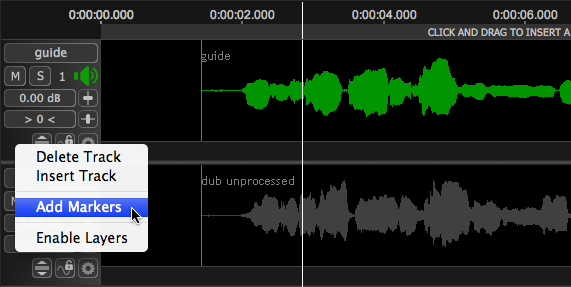
By RIGHT CLICKing an area in the Track Control panel, the above menu will appear, and if Add Markers is selected, the additional small track highlighted in red below will appear.

By RIGHT CLICKing in this area, the following menu will appear.
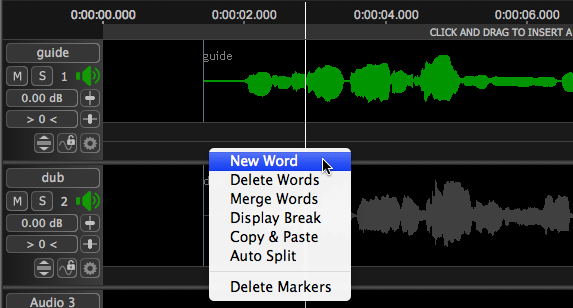
If New Word is selected, an area will be reserved at the location of the Playhead and the user can type directly into that track. (Here the words "New Words Can Be Typed Directly Into This Track" have been entered.)

The next step is usually to bring up the same menu and select Auto Split.
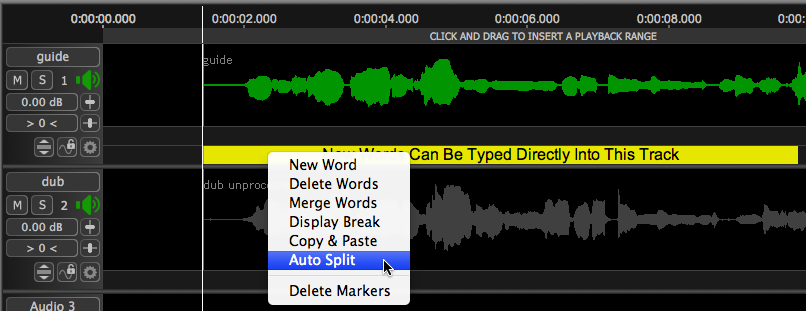
This will break each word into it's own moveable block as shown below.

The selected block is shown in yellow and the edges of words can be dragged either direction to make the start and/or stop coincide with the related audio, as shown below.
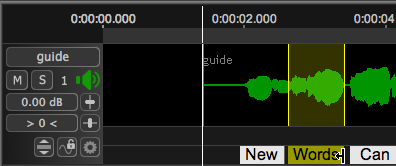
Similarly, if the cursor is a double headed arrow, then the boundary between two words can be adjusted by dragging.
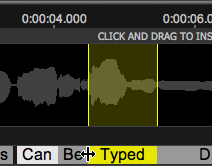
In addition, groups of words can be made with a SHIFT selection, as shown below.
Additional operations in the menu can merge groups of words, Delete them, and copy and Paste into empty areas of sufficient length.
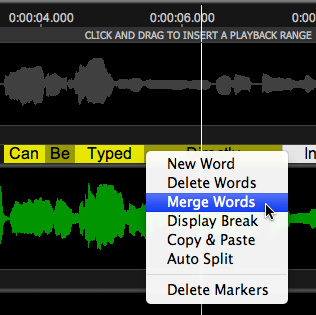
The purpose of these operations is to adjust the starts and/or ends of the words and blocks of words to provide visual cues as to the content of the audio throughout the track.
Back to Index
Scrolling the display
From version 3.1 onwards, the scroll control (mouse wheel, two-fingered vertical swipe, etc) scrolls the pitch display on a track where this is active. SHIFT-scrolling scrolls the entire track display.
Locations of Files
We describe here where the files used by Revoice Pro are located, first for Mac OS and then Windows.
Mac OS
All Revoice Pro files can be deleted if start-up problems occur that seem file related.
File Path Description Conventions
~ at the start of a path indicates the user home directory.
/ indicates the root directory
The Library folder is hidden on OS X 10.7 and later. An easy way to make the folder visible in the Finder is to select the Help -> Search menu and enter Library and follow the instructions.
Preference Files
Sessions Recent File List
~/Library/Preferences/com.synchroarts.Revoice-Pro.LSSharedFileList.plist
User Preferences
Contains preference settings including interface colours and operation warnings.
~/Library/Preferences/com.synchroarts.Revoice-Pro.plist
User Presets
- APT Presets
- ~/Library/Application Support/SynchroArts/RevoicePro/APT
- Doubler Presets
- ~/Library/Application Support/SynchroArts/RevoicePro/Doubler
Session templates
- ~/Library/Application Support/SynchroArts/RevoicePro/SessionTemplate
- The file "Default.RPPreset" is the Default template for new sessions.
You can delete this file to restore the "Factory Default" parameters for new sessions.
Shared Presets
- To add a shared preset you should save the preset into your user preset folder. Then, using the Finder, copy the preset into the shared folder.
- To do this you will need an Admin password and you may have to create the folders in the path.
APT Presets Location
/Library/Application Support/SynchroArts/RevoicePro/APT
Doubler Presets Location
/Library/Application Support/SynchroArts/RevoicePro/Doubler
Windows OS
Default Presets and Templates
If the user pastes the following path into Windows Explorer
%APPDATA%\SynchroArts\RevoicePro\Presets
the file system will show the folders with names in bold below:
APT - contains default and user APT presets
Doubler - contains default and user Doubler presets
Session Template - contains default and Session Template file.
The file "Default.RPPreset" is the Default template for new sessions.
You can delete this file to restore the "Factory Default" parameters for new sessions.
Deleting the files in each of those folders will restore that template to the "Factory Setting"
Temporary Audio File Locations
From v3.3 you can choose where Revoice Pro stores its temporary audio files. If your DAW is not copying files created by Revoice during drag-and-drop export into a folder under its control, the audio files may be lost when the default temporary folder is cleared out. If you set the temporary files location yourself, you can ensure they are not deleted automatically.
Towards the bottom of the Preferences dialog, select Set Location... to choose a folder where temporary audio files will be stored. Files are stored in a logical and clearly named hierarchy, with dates taken into account. Choose Automatic to store them in the place chosen by the current session.

Auto Save Option
From v3.3 you can choose to automatically save sessions. From the Preferences dialog, check the Automatically Save Sessions box (see above).
Back to Index
Audio Layers
The purpose of providing an optional set of Audio Layers in each track is to allow the construction of assembled pieces of audio that can have their playback relationships changed easily.
There are four available Layers provided in each track - and they contribute to the main track according to the following simple rule. Any audio in a higher layers that is "visible" from the top of the stack is audio that will add to the composite track and will be heard. No audio beneath audio in another layer will add to the output..
One simple two-layer example is that a small section of audio in a layer on top of a longer section in a layer beneath the top layer, would act like a "moveable drop-in" and "cover up" whatever audio was below it. This would allowing a word or phrase to be replaced by the drop in, but not destructively.
Uninstalling Revoice Pro
Windows
Simply run the Uninstaller.
Mac OSX
To remove Revoice Pro and its plug-ins from OS X you need to delete the following files:
In the Applications folder delete Revoice Pro: /Applications/Revoice Pro.app
To delete the plug-ins you need to delete the following files:
/Library/Application Support/Avid/Audio/Plug-Ins/RevoiceProLink.aaxplugin
/Library/Application Support/DigiDesign/Plug-Ins/RevoiceProLink.dpm
/Library/Audio/Plug-Ins/Components/RevoiceProMonitor.component
/Library/Audio/Plug-Ins/Components/RevoiceProLink.component
/Library/Audio/Plug-Ins/VST3/RevoiceProLink.vst3
/Library/Audio/Plug-Ins/VST3/RevoiceProMonitorVST.vst3

